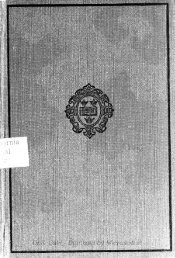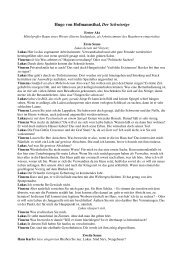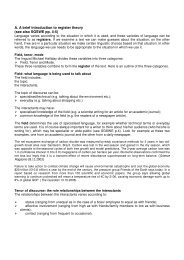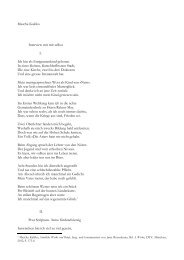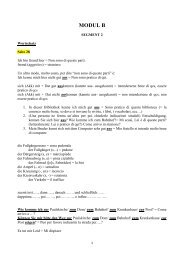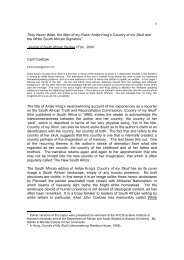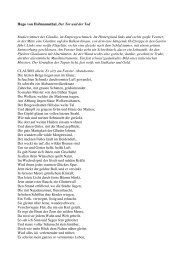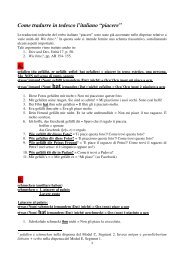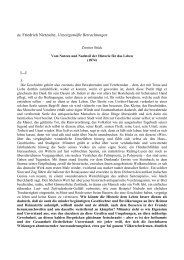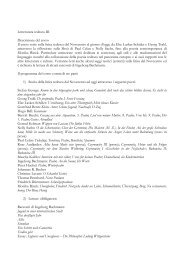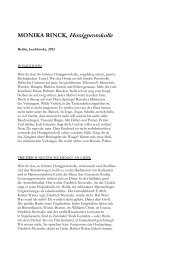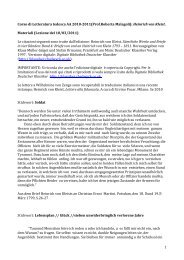Methodological Perspectives on Second Language Prosody
Methodological Perspectives on Second Language Prosody
Methodological Perspectives on Second Language Prosody
You also want an ePaper? Increase the reach of your titles
YUMPU automatically turns print PDFs into web optimized ePapers that Google loves.
speakers. The rhythmic-prosodic transplantati<strong>on</strong><br />
technique is based <strong>on</strong> the algorithm PSOLA<br />
implemented in Praat and illustrated in [24].<br />
Figure 4: Comprehensibility: NNSs’ average values.<br />
Table 5: Percentage values of credibility of original<br />
and modified speech: t<strong>on</strong>al range (TR).<br />
% credibility<br />
% credibility<br />
Synthesized speech<br />
original<br />
decreased increased Δ<br />
TR<br />
TR TR<br />
51 45 -6<br />
43 56 +13<br />
35 58 +23<br />
60 41 -19<br />
23 44 +21<br />
10 32 +22<br />
Table 6: Percentage values of credibility of original<br />
and modified speech: silent pauses (SL).<br />
Synthesized speech<br />
original<br />
Decreased increased Δ<br />
SL<br />
SL SL<br />
51 42 -9<br />
52 57 +5<br />
43 58 +15<br />
35 38 +3<br />
60 50 -10<br />
10 17 +7<br />
In the fourth perceptive test, in order to<br />
evaluate the impact of anomalous prosodic and<br />
segmental performances <strong>on</strong> the degree of the<br />
perceived foreign accent, listeners were asked to<br />
rate not <strong>on</strong>ly comprehensibility and credibility, but<br />
also foreign accent <strong>on</strong> a three-point scale (1=<br />
native speaker; 3= str<strong>on</strong>g foreign accent).<br />
For this experiment, the voices of the sec<strong>on</strong>d<br />
test were used, but the native <strong>on</strong>e has not been<br />
modified. The n<strong>on</strong>-native speakers were all<br />
str<strong>on</strong>gly foreign accented.<br />
3.2. First step: removing disfluencies and<br />
cl<strong>on</strong>ing native pauses<br />
The perceptive test carried out after having<br />
removed all the disfluencies and cl<strong>on</strong>ed the native<br />
pauses, both in terms of positi<strong>on</strong> and durati<strong>on</strong>,<br />
attested an increasing value of “sufficient” and<br />
“good” comprehensibility ratings for all foreigners<br />
(Fig. 4).<br />
As for the foreign accent, almost all the<br />
listeners correctly recognized the NNSs (Fig. 5).<br />
The modificati<strong>on</strong>s carried out <strong>on</strong> NNSs’ utterances<br />
produced a slight decrease of the “str<strong>on</strong>g foreign<br />
accent” ratings (from 69% to 60%). In additi<strong>on</strong>, it<br />
is worth noting that the 5% of the listeners<br />
assumed to have heard a native voice.<br />
Figure 5: Foreign accent: NNSs’ average values (%).<br />
The removal of the disfluencies and the silences<br />
changes determined a significant increase in the<br />
level of news credibility (Fig. 6), taking the NNSs’<br />
values to levels very close to those of the NS (true:<br />
46%; false: 54%).<br />
Figure 6: Credibility: NNSs’ average values (%).<br />
7



